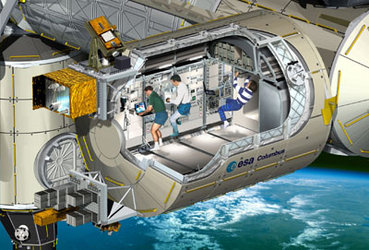Ceremony for the completion of the Columbus laboratory
At a ceremony to mark the delivery of the European laboratory for the International Space Station, Columbus, by EADS SPACE Transportation to ESA, held in Bremen on 2 May 2006, German Chancellor Angela Merkel emphasised the international cooperation aspects of Columbus and the ISS, as an example for a world with less boundaries.
In front of Jean-Jacques Dordain, Director General of ESA, Evert Dudok, EADS Space Transportation President, Jens Böhrnsen, Lord Mayor of Bremen and over 700 international participants gathered in a brand new assembly hall for the future Airbus transport aircraft A400, Chancellor Merkel expressed her view that research under weightlessness has brought incredible progress to the various disciplines involved and considered the scientific possibilities provided by the Columbus laboratory as being of inestimable value. She considered Columbus a fascinating example for high-technology that first travels the world and then travels around the Earth. She also hoped that NASA would give Columbus a safe journey into space. She noted with satisfaction that the Columbus launch had advanced in the ISS assembly sequence and added that Europe would be highly pleased and prepared even to advance one position further in the launch calendar.

Herself a scientist, with a doctorate in physical chemistry, Chancellor Merkel pointed out that the nice aspect of fundamental research is that sometimes something totally different comes out of it than initially expected. Therefore, politicians should leave research the freedom of accomplishment, even if it does not always lead to an immediate and measurable profit. Although space industry accounts only for a relatively small portion of the economy, it is at the same time an excellent portion which particularly suits a country like Germany that considers itself a leader in high-technology and science. Beyond its material value, having a space industry also has a symbolic force and this needs to be continued. Chancellor Merkel underlined the importance of close communication between politics, science and technology. This dialogue is necessary for politicians to be able to ask the right questions with the right words.

Chancellor Merkel wished Thomas Reiter, the German ESA astronaut who is scheduled to fly to the International Space Station in July, a happy and interesting journey, and success with all the experiments that he will conduct. She extended her thanks for having completed Columbus to all staff involved in the project. She considered this to be a fascinating task, but also a task which requires full attention and does not allow for mistakes. The German Chancellor concluded her speech by wishing Columbus a happy journey and to all participants a good international cooperation in the space industry for the benefit of humans all over the Earth.

ESA Director General, Jean-Jacques Dordain, thanked all the industrial teams throughout Europe and emphasised the importance of Columbus as a technology driver for European industry and as a basis for European researchers to perform world-class research in space. The Chairman of the ESA Council and Chairman of the Board of the German Aerospace Centre DLR, Prof. Sigmar Wittig, explained the role that Germany plays in the ESA programme for the European participation in the ISS and the role of DLR as the operator of ESA's mission control centre for Columbus, located in Oberpfaffenhofen near Munich, Germany. He also explained the interest of German scientists for research on Columbus and the Space Station. As the first German and European scientist to use the ISS for physical experimentation, Prof. Gregor Morfill, from the Max-Planck-Institute for Extraterrestrial Physics in Garching, near Munich, presented the physical principles and the research objectives of the plasma crystal experiment created by him and his scientific team.

Representing the agency that will soon receive the European laboratory in order to prepare for launch and transport to the Space Station, NASA Deputy Administrator Shana Dale provided further information on the place of Columbus in the Space Shuttle mission calendar for the further build-up of the ISS. She also presented NASA's plan for the future operation of the Station. As other participants, she emphasised the importance of the programme as a symbol for international cooperation on a global scale. In a recorded video address from space, the two present inhabitants of the ISS, Pavel Vinogradov (Roscosmos) and Jeffrey Williams (NASA) welcomed the audience in Bremen and congratulated the European teams who helped to develop and build this masterpiece of engineering work for the successful completion of Columbus.
In the honour of the men and women who made Columbus, the three Columbus project managers - Bernardo Patti (ESA), Günter Brandt (EADS Space) and Dino Brondolo (Alcatel Alenia Space) - fixed two aluminium plates on one of the internal walls of Columbus, laser-engraved with the names of the more than 500 employees in industry and ESA involved in the Columbus project.

To conclude the event, primary school children from Bremen came to the stage, to the sounds of the song by Queen, "Friends will be Friends", and presented white handkerchiefs to the dignatories on stage. The children wished good luck and a safe journey to Columbus in as many European languages as they knew. Noticing that no one on the stage had made a wish in Russian, the German Chancellor added herself a "tchaslivovo puti" to the chorus of good wishes.
At the end of May, Columbus will be carried onboard an Airbus A300-600 'Beluga' heavy lift aircraft from Bremen to NASA's Kennedy Space Center in Cape Canaveral, Florida, where it is expected to land on the same landing strip as NASA's Space Shuttles.







